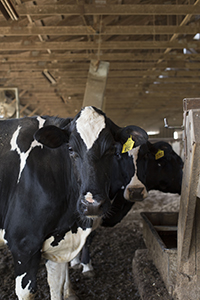 The high-risk fresh cow: She's older (third lactation or greater), had a difficult calving and is battling lameness. She had a longer lactation (more than 350 days) the year before and produced above the herd average.
The high-risk fresh cow: She's older (third lactation or greater), had a difficult calving and is battling lameness. She had a longer lactation (more than 350 days) the year before and produced above the herd average. You know what she looks like, but can you pick her out in the crowd? According to Nigel Cook with the University of Wisconsin School of Veterinary Medicine, the number one factor impacting performance as herd size grows is the ability to find the sick cow in the fresh cow pen.
Milk weights, temperature loggers, activity and rumination monitors, and rumen pH are tools that help us select the cows we need to work on, but most rely on the cow becoming sick. "They need her to be sick -- quite sick -- to find her," Cook said during his presentation at a University of Wisconsin-Extension dairy modernization meeting.
Oftentimes, the search for sick cows requires time spent in the headlocks, but excessive time locked up is time away from rest and water, Cook explained. "What damage are we causing other cows trying to find the three sick ones?"
Cook stated that cows in headlocks need to be processed in less than an hour, for the benefit of sick and healthy cows. "Cows are very busy creatures," he said, "and oftentimes we are stealing their resting time."
If you know what cows are at high risk, extra care can be offered early on, before more problems occur.
Housing
The preferred location for springing and fresh cows is a bedded pack, with sand-bedded stalls as option two. "We want her to be comfortable, with less competition for resting space," Cook said.
Prevent subclinical disease
"We've focused on the clinical problems, but the subclinical have often been missed," Cook said. He recommends offering routine oral calcium at calving and 12 to 24 hours after calving, and oral propylene glycol dosing based on the herd testing protocol.
Manage lameness
"Lameness is a fresh cow disease," he said, "and it is a risk factor for ketosis, DAs and so on."
And, unfortunately, lameness problems accumulate with age. "A problem in the prior lactation comes back to haunt you," Cook said. He recommends milking lame, high-risk fresh cows twice a day and no more, which is opposite the milking fresh cows frequently trend from five years ago. "It takes the pressure off, giving them longer to eat and rest."
Enough staff
Research done by Cook and his colleagues revealed that ample staffing is critical. "Inadequate staffing emerges as the number one factor limiting overall performance."
With these actions in mind, farms can fend off some of the problems high risk cows face and keep their fresh cows fresher.

The author is an associate editor and covers animal health, dairy housing and equipment, and nutrient management. She grew up on a dairy farm near Plymouth, Wis., and previously served as a University of Wisconsin agricultural extension agent. She received a master's degree from North Carolina State University and a bachelor's from University of Wisconsin-Madison.








